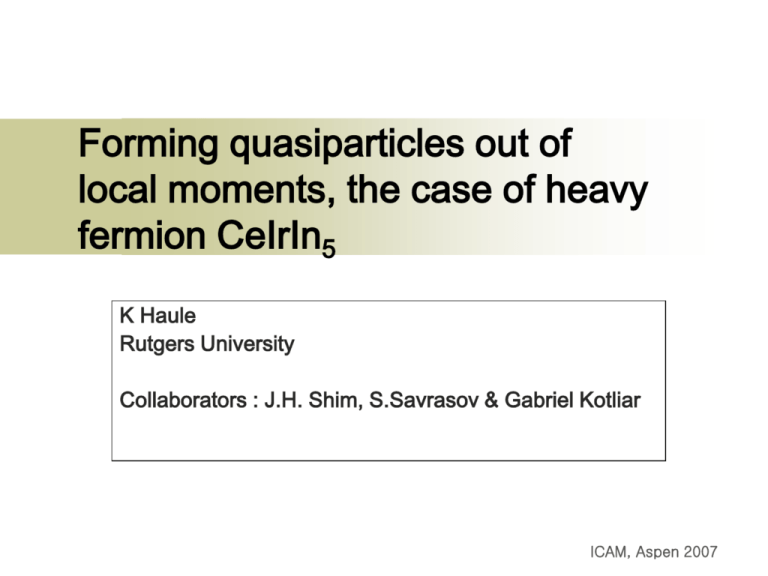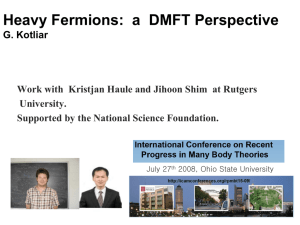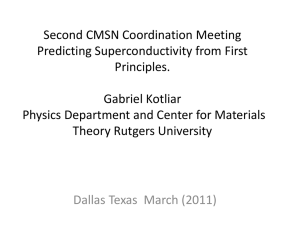슬라이드 1 - Rutgers University
advertisement

Forming quasiparticles out of local moments, the case of heavy fermion CeIrIn5 K Haule Rutgers University Collaborators : J.H. Shim, S.Savrasov & Gabriel Kotliar ICAM, Aspen 2007 Outline LDA+DMFT results for CeIrIn5 Local Ce 4f - spectra of CeIrIn5 and comparison to AIPES) Momentum resolved spectra and comparison to ARPES Optical conductivity Two hybridization gaps and its connection to optics Fermi surface in DMFT Aspen 2007 Standard theory of solids Band Theory: electrons as waves: Rigid band picture: En(k) versus k Landau Fermi Liquid Theory applicable Very powerful quantitative tools: LDA,LSDA,GW Predictions: M. Van Schilfgarde •total energies, •stability of crystal phases •optical transitions Aspen 2007 Strong correlation – Standard theory fails Fermi Liquid Theory does NOT work . Need new concepts to replace rigid bands picture! Breakdown of the wave picture. Need to incorporate a real space perspective (Mott). Non perturbative problem. Aspen 2007 Universality of the Mott transition Crossover: bad insulator to bad metal Critical point First order MIT V2O3 Ni2-xSex k organics 1B HB model (DMFT): Aspen 2007 Basic questions How to computed spectroscopic quantities (single particle s pectra, optical conductivity phonon dispersion…) from first principles? How to relate various experiments into a unifying picture. New concepts, new techniques….. DMFT maybe simplest ap proach to meet this challenge Aspen 2007 DMFT + electronic structure method Basic idea of DMFT: reduce the quantum many body problem to a problem of an atom in a conduction band, which obeys DMFT self-consistency condition (A. Georges et al., RMP 68, 13 (1996)). DMFT in the language of functionals: DMFT sums up all local diagrams in BK functional Basic idea of DMFT+electronic structure method (LDA or GW): For less correlated bands (s,p): use LDA or GW For correlated bands (f or d): add all local diagrams by solving QIM (G. Kotliar S. Savrasov K.H., V. Oudovenko O. Parcollet and C. Marianetti, RMP 2006). Aspen 2007 Continuous time “QMC” impurity solver, expansion in terms of hybridization K.H. Phys. Rev. B 75, 155113 (2007) P. Werner, Phys. Rev. Lett. 97, 076405 (2006) General impurity problem k Diagrammatic expansion in terms of hybridization D +Metropolis sampling over the diagrams •Exact method: samples all diagrams! •Allows correct treatment of multiplets Aspen 2007 Crystal structure of 115’s Tetragonal crystal structure Ir IrIn2 layer In Ce CeIn3 layer IrIn2 layer 4 in plane In neighbors Ce In 8 out of plane in neighbors In Aspen 2007 Phase diagram of 115’s Why CeIrIn5? •Ir atom is less correlated than Co or Rh (5d / 3d or 4d) •CeIrIn5 is more itinerant(coherent) than Co (further away from QCP) CeCoIn5 CeRhIn5 CeIrIn5 Tc[K] 2.3K 2.1K@p> 1.5GPa 0.4K Cv/T[mJ/molK^2] 300 50 750 Aspen 2007 Coherence crossover in experiment ALM in DMFT Schweitzer& Czycholl,1991 Crossover scale ~50K •High temperature Ce-4f local moments out of plane in-plan e •Low temperature – Itinerant heavy bands Aspen 2007 Issues for the system specific study •How does the crossover from localized moments to itinerant q.p. happen? ? •Where in momentum spac e q.p. appear? A(w) •How does the spectral weight redistribute? w k •What is the momentum dispersion of q.p.? •How does the hybridization gap look like in momentum spa ce? Aspen 2007 Temperature dependence of the local Ce-4f spectra •At 300K, only Hubbard bands •At low T, very narrow q.p. peak (width ~3meV) •SO coupling splits q.p.: +-0.28eV SO •Redistribution of weight between the q.p. and the upper Hubbard band (e Aspen 2007 Buildup of coherence coherent spectral weight Buildup of coherence in single impurity case T TK Very slow crossover! coherence pea k scattering rate coherent spectral weight Slow crossover more consistent with NP&F T T* NP&F: Nakatsuji,Pines&Fisk, 2004 T* Crossover around 50K Aspen 2007 Angle integrated photoemission vs DMFT Experimental resolution ~30meV, theory predicts 3meV broad band Surface sensitive at 122eV ARPES Fujimori, 2006 Aspen 2007 Angle integrated photoemission vs DMFT Lower Hubbard band Nice agreement for the • Hubbard band position •SO split qp peak Hard to see narrow resonance in ARPES since very little weight of q.p. is below Ef ARPES Fujimori, 2006 Aspen 2007 Momentum resolved Ce-4f spectra Af(w,k) Hybridization gap Fingerprint of spd’s due to hybridization q.p. band SO T=10K scattering rate~100meV T=300K Not much weight Aspen 2007 Quasiparticle bands LDA bands LDA bands DMFT qp bands DMFT qp bands three bands, Zj=5/2~1/200 Aspen 2007 Momentum resolved total spectra Most of weight transferred into the UHB LDA+DMFT at 10K A(w,k) ARPES, HE I, 15K LDA f-bands [-0.5eV, 0.8eV] almost disappear, only In-p bands remain Very heavy qp at Ef, hard to see in total spectra Below -0.5eV: almost rigid downshift Unlike in LDA+U, no new band at -2.5eV Fujimori, 2003 Large lifetime of HBs -> similar to LDA(f-core) rather than LDA or LDA+U Aspen 2007 Optical conductivity F.P. Mena & D.Van der Marel, 2005 Typical heavy fermion at low T: no visible Drude peak w no sharp hybridization gap k first mid-IR peak at 250 cm-1 Narrow Drude peak (narrow q.p. band) Hybridization gap second mid IR peak at 600 cm-1 CeCoIn5 Interband transitions across hybridization gap -> mid IR peak E.J. Singley & D.N Basov, 2002 Aspen 2007 Optical conductivity in LDA+DMFT •At 300K very broad Drude peak (e-e scattering, spd lifetime~0.1eV) •At 10K: •very narrow Drude peak •First MI peak at 0.03eV~250cm-1 •Second MI peak at 0.07eV~600cm-1 Aspen 2007 Multiple hybridization gaps eV 10K non-f spectra 300K In Ce In •Larger gap due to hybridization with out of plane In •Smaller gap due to hybridization with in-plane In Aspen 2007 Fermi surfaces of CeM In5 within LDA Localized 4f: LaRhIn5, CeRhIn5 Shishido et al. (2002) Itinerant 4f : CeCoIn5, CeIrIn5 Haga et al. (2001) Aspen 2007 de Haas-van Alphen experiments LDA (with f’s in valence) is reasonable for CeIrIn5 Experiment LDA Haga et al. (2001) Aspen 2007 Fermi surface changes under pressure in CeRhIn5 localized itinerant Shishido, (2005) Fermi surface reconstruction at 2.34GPa Sudden jump of dHva frequencies Fermi surface is very similar on both sides, slight increase of electron FS frequencies Reconstruction happens at the point of maximal Tc We can not yet address FS change with pressure We can study FS change with Temperature - At high T, Ce-4f electrons are excluded from the F At low T, they are included in the FS Aspen 2007 Electron fermi surfaces at (z=0) Slight decrease of th e electron FS with T LDA M X M X G X M X M a2 LDA+DMFT (10 K) LDA+DMFT (400 K) a2 Aspen 2007 Electron fermi surfaces at (z=p) No a in DMFT! No a in Experiment! LDA A R A R Z R A R A Slight decrease of th e electron FS with T LDA+DMFT (10 K) LDA+DMFT (400 K) a3 a3 a Aspen 2007 Electron fermi surfaces at (z=0) Slight decrease of th e electron FS with T LDA+DMFT (10 K) LDA M X M X G X M X M LDA+DMFT (400 K) b1 b1 b2 b2 c Aspen 2007 Electron fermi surfaces at (z=p) No c in DMFT! Slight decrease of th No c in Experiment! e electron FS with T LDA+DMFT (10 K) LDA A R A R Z R A R A b2 LDA+DMFT (400 K) b2 c Aspen 2007 Hole fermi surfaces at z=0 Big change-> from small hole like to large electron like LDA+DMFT (10 K) LDA M X e1 M g X G X M X M LDA+DMFT (400 K) h g h Aspen 2007 Hole fermi surface at z=p LDA A R A R Z R A R A LDA+DMFT (10 K) LDA+DMFT (400 K) No Fermi surfaces Aspen 2007 Fermi surfaces Increasing temperature from 10K to 300K: Gradual decrease of electron FS Most of FS parts show similar trend Big change might be expected in the G plane – small hole like FS pockets (g,h) merge into electron FS e1 (present in LDA-f-core but not in LDA) Fermi surface a and c do not appear in DMFT results Aspen 2007 Conclusions Crossover from local moment regime to heavy fermion state is very slow. Width of heavy quasiparticle bands is predicted to be only ~3meV. We predict a set of three heavy bands with their dispersion. Mid-IR peak of the optical conductivity is split due to pres ence of two type’s of hybridization Ce moment is more coupled to out-of-plane In then in-plane In Fermi surface changes gradually with temperature and most of electron FS parts are only slightly decreases with increa sing temperature. Hole pockets merge into e1 electron FS. Aspen 2007 ARPES of CeIrIn5 Fujimori et al. (2006) Aspen 2007 dHvA frequencies Exp LDA DMFT 10K 4.53 b1 --- B2 6.116.59 a1 5.075.56 5.09 a2 4.53 4.08 3.80 a3 4.24 3.83 3.27 electron Fermi surfaces Aspen 2007 Ce 4f partial spectral functions LDA+DMFT (10K) LDA+DMFT (400K) Blue lines : LDA bands Aspen 2007









